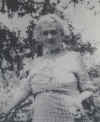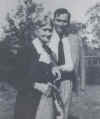
 Journal
Journal
Jane "Janie" Vardell Lawton Varn
Preface Ü
My Grandmother, Jane Vardell Lawton Varn, kept a Journal from the time she was a young woman until a couple of months before she died. The oldest surviving entry is dated March 19, 1886, and the last one was written on May 18, 1955. She followed no particular pattern in setting down entries. In her old age they tended to be almost daily, but earlier in life she might skip weeks or even months without writing anything. In between the record becomes even more erratic; thus, on January 25, 1903 she wrote, "Not a single record for 1902! How strange that I should have neglected you, old journal." The longest gap of all stretches from 1928 to 1941, but I rather imagine that the problem there is the loss of some of her notebooks. From 1941 through 1943, for example, she kept her records on loose "Statement" sheets apparently used for billing purposes. The surviving sheets came to me tucked into one of the lined Composition Books she used for later entries. It would be surprising if much had not been lost from records kept in this fashion.
The records that I have are in the form of six "volumes." The three oldest are contained in 4 x 9-inch, lined memo pads, originally leather bound, with a note, "For a duplicate of this pad, ask for Congress Memorandum Tablet, No. 0801. Patented December 4, 1883." The covers are missing from the two oldest as well as one or more pages from the front and back of each of those pads. The loose Statement sheets referred to above comprise Volume IV, and Volumes V and VI are contained in two soft-cover, lined Composition Books. The writing itself is still surprising easy to read, especially where Grandmother used pen and ink. The exceptions are in the Memo Tablets with the missing covers, several pages of which are badly faded and brown and hard to read. There are also entries written with an "unsharpened" pencil; these, too, can be difficult to decipher. However, I believe that I have been able to transcribe most of the Journal reasonably accurately, while acknowledging that some of the proper names, especially, may not be quite right.
Grandmother recorded "events" in her Journal as would any diarist, as in her description of Charleston's great earthquake in September, 1886 — "My God, what a time we did have Tuesday night a week ago. An earthquake ..." But the Journal was special to her and more important in other ways. She frequently referred to it directly by name in the second person: "... I have neglected you, old journal." In times of stress she used it as a sort of catharsis, pouring out her self doubts, composing desperate prayers and pleas for Divine help, as well as heaping praise on or venting her displeasure at the actions of her many relatives and acquaintances. Despite the gaps in the story, one comes to understand the insecurity and loneliness of a young woman struggling with a growing deafness; her uncertainties as she faced the prospect of marriage but the joyful fulfillment of married life; her satisfaction in motherhood; her total and lasting anguish over the loss of her second child and her search for the sin that brought down such awful punishment from God; the healing and love produced by the births of her other three children; her maturing relationship with her husband; and finally the love, the frustration, the residual sibling rivalry as she takes care of her spinster sister and copes herself with the loss of her husband, her home, and the encroaching infirmities of old age.
As her first grandchild, I got to name her "Nammie." I knew her as a grandmother, someone who dispensed love with a certain reserve and who got respect without ever demanding it. Someone who gave me her bound copies of Shakespeare's plays without quite letting me know what reading meant to her. Having read her Journal, however, I am able to appreciate her strengths and weaknesses, her many very human longings and human foibles, her courage, and her deep love for her children and grandchildren. I see her more as a person than as a grandmother. I think of her now not so much as "Nammie" but as Janie!
Because I reacted to the Journal in the way I have just described and because the original Journal is much too fragile to be widely circulated, I was prompted to make this transcription in hopes that other of her descendants, now and in the future, will be interested in understanding better one source of our commonly shared genes!
Reading the journal of a person born a century and a quarter ago can be confusing without a little background:
Jane Vardell Lawton was born on Feb. 7, 1863, the eighth of ten children of Sarah Rivers and James Monroe Lawton, Sr. Five of the ten children died in infancy. The survivors included two boys, Rawlins Rivers ("Brother" in the Journal) and James M, Jr. ("Nimmie"), and three girls, Arabella Valeria ("Belle" or more often "Sissie"), Jane ("Janie" to her sisters), and Anne ("Annie"). Arabella was six years older than Jane, and Annie four years younger.
The family owned a large plantation (40 slaves) on James Island near Charleston, S.C. During the Civil War the family moved to Charleston and eventually after the war to Summerville, S. C., about 20 miles inland from Charleston.
As with most southern families after The War, money was somewhat scarce in the Lawton household, and Janie served as a governess for the children of some of her many cousins for a time and also taught school in several small towns, almost all of them close to Charleston. The last was a place called Weimers in Colleton County, S. C. not far from Charleston and Beaufort where she boarded with Miss Mamie Varn. It was there, apparently, that she met her future husband, John Varn. They were married in August of 1892 and set up housekeeping in Miley, S. C. (also in Colleton Co.) where their first two children were born. Eventually they moved to Beaufort, S. C. and after various false starts, my grandfather became a prosperous truck farmer. Financial calamity eventually overtook him, however, forcing him to sell his house in Beaufort and move in the late 1920's to Pleasant Farm a short distance outside the town. There they lived until John Varn suffered a heart attack in 1939.
The heart attack left Grandfather in such a condition that it was deemed he could no longer manage his farm. As a result he and Janie left Pleasant Farm and went to live at Frogmore, S. C. on St. Helena's Island about 6 miles from Beaufort where they stayed with their daughter Hazel Walpole and her husband, LeRoy, and their two children, James and Jane until John's death a few months later in January of 1940. Janie eventually moved back to Beaufort to help care for her blind, spinster sister Belle ("Sissie") after Mary Lawton[1] (Nimmie's widow) died. (Sissie had lived with Mary Lawton ever since Mary's husband died in 1927.) The two sisters, Janie and Sissie, were devoted pair but found it somewhat difficult to abide one another, but that is a tale you can read about in the Journal. Suffice it to say that after Sissie died, Janie moved back to Frogmore where she stayed until her own death in 1955.
That is a thumbnail sketch of a life that took many a turn in the living of it. I hope that it will provide a little framework as you wade into the sometimes confusing world of cousins, aunts, and uncles and numerous outsiders whose names will not be known to you. Persevere, however, and I believe that you will find the effort a rewarding one.
John Varn
Cathcart
Knoxville,
Tennessee
December, 1993.
[1] Mary Lawton was known in my family as "Big Aunt Mary" as distinguished from my mother's sister Mary. Interestingly enough, she was a Yankee from New Jersey whom my Great Uncle Jim married in 1898 and brought back to the heart of the old Confederacy!
Volume 1 -- March 19, 1886 to June 19, 1889
Volume 2 -- July 17, 1889 - October 29, 1899
Volume 3a -- October 29, 1899 - July 22, 1928
Volume 3b -- September 1, 1939 – March 15, 1941
Volume 4 -- August 17, 1941 - August 22, 1943
Volume 5 -- October 1, 1943 - June 13, 1947
Volume 6 -- July 5, 1947 - May 2, 1955
